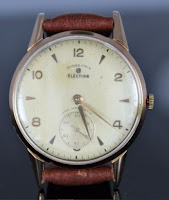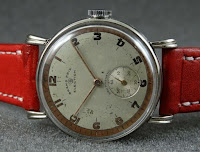By Bruce Shawkey
In April
1892 the Swiss watch company Louis Brandt & Frere registered the name “Helvetia”
as one of their brand names. Yes, THAT Louis Brandt, who founded Omega, along
with brother Cesar. Helvetia (pronounced hel-VEESH-ah) was the personified female
symbol for Switzerland, much the same way Lady Liberty is a symbol for the
United States. Helvetia goes way back to when Switzerland was part of Roman
empire, and for whatever reason, the symbol stuck. Anyway, two years later in
1894 (Louis) Brandt also registered the name “Omega” and applied it to a new
range of higher quality lever movement watches they had developed. Helvetia at
the time used cheaper cylinder movements. The Omega brand became so popular
that Brandt decided to spin off Helvetia along with several other brands into a
new company called "Société d’Horlogerie La Générale" or General
Watch Co. in its American translation. Louis’ brother Cesar, was made a
principal in the company.
Helvetia
soon became the flagship brand of General and the company started putting better
quality lever escapement movements inside their cases (circa 1895). Their early
history as cylinder watches I think is what gives Helvetia a bad rep among
collectors. But as far as I know, Helvetia used lever escapement movements from
this point forward.
Helvetia
wrist watches appeared as early as 1909. During the Great War, General produced
Helvetia watches of the hunter or half hunter types that included a hinged lid
to protect the crystal and hands of the watch from damage.
Helvetia trench watch with hunter case, copyright https://www.helvetiahistory.co.uk/history, used with permission,
After WWI, General
began pushing the brand name Helvetia to the fore. They introduced some of
their first dress watches, and developed a shock protecting mechanism into their
movements. From this point forward, almost all General’s watches bore the name
Helvetia. Before this, the dials had been mostly left without signature.
In 1929,
they produced a waterproof watch in a case with gaskets in the stem and case
back. In 1932 they produced a watch with a large, twin-window, twin-wheel, date feature at 12
o’clock, claiming the world’s first "Big Date" watch.
Helvetia "Big Date" copyright https://www.helvetiahistory.co.uk/history, used with permission,
We normally
associate this feature with the more expensive brands such as Glashutte and
Lange & Sohn, but reportedly Helvetia was the first.
The second
world war was another time of expansion for the company. They supplied pocket
watches to the British and the German armies. Also, they supplied wristwatches
to Germany and, at the end of the war, to Allied forces, as well as special
wrist timers to the Royal Navy. After the war, they changed their name to Montres
Helvetia Société d'Horlogerie La Générale to emphasize the prominence of the
Helvetia brand. From this date forward, they are usually referred to as Montres
Helvetia S.A. or Helvetia Watch Co.
The 1950s
were probably the last hurrah for Helvetia. They turned their attention more
toward dress watches, as evidenced by this pictured ad in a 1953 issue of Swiss Horological Journal.
Swiss Horological Journal Nov./Dec. 1953
They
again became quite innovative with some interesting dial and case designs. This
was the beginning of the widespread use of automatic movements, and Helvetia
followed suit, using some of their own movements, as well as ebauches (rough
movements) from ETA and A. Schild. They even produced watches in karat gold
cases, something they had not done before,
Dog ear lugs, 14kt gold case
Chronograph with Valjoux 23 movement
The 1960s
began a downward spiral for Helvetia, first with having to compete with cheap Japanese imports and
then in the ‘70s-'80s with the quartz invasion. In an attempt to modernize, Helvetia
adopted a more streamlined logo.
Automatic, new logo
In 1965, catchy model names were added such as
the Waterstar, Cosmotimer, and Depthograph."Depthograph" with built-in depth gauge
Despite their still being quality watches,
Helvetia struggled. They became part of a consortium (SGT, short for Société des
Garde-Temps S.A.) Other companies in the consortium included Avia, Degoumois
& Co., Silvana, Eugene Vuilleumier, William Mathez and Fleurier. This was a
common practice in those days for watch companies to band together to reduce operating
expenses. By the early ‘70s, Helvetia ceased production of all in-house
movements.
In 1973 at
the annual general meeting of Helvetia S.A., it was decided to dissolve the
company. This was not the end for the Helvetia name however. Silvana S.A. held
its own annual general meeting on the same day as Helvetia's, and Silvana S.A.
changed its name to Helvetia S.A. This is not as unusual as it might sound, as
both companies were part of the same SGT consortium and most of the companies’
directors sat on both boards. This appears to be little more than a paper
exercise designed to shuffle assets.
In any event,
SGT could not hold off the quartz invasion of the 1980s, and began selling off
its brands one by one. The Helvetia name was eventually picked up by a jeweler
in Vienna, Austria, who still sells some watches with the Helvetia logo. But
they are watches in name only, using generic movements and cases.
Vintage
examples, meanwhile, seem to draw little interest among today’s collectors. Sellers ask big bucks on eBay, but they bring no action and often sell for a fraction of the asking price. The exception are the WWI era military watches, but they are in a separate collector niche. That is why, in my opinion, Helvetia wristwatches, for the most part, represent a good value.
For more
detailed information, please check out this website, devoted to the company’s history and watches. I have based this
abbreviated history in large part on the information contained on that website.
Here's another article I wrote on Helvetia:
In April 1892 the Swiss watch company Louis Brandt & Frere registered the name “Helvetia” as one of their brand names. Yes, THAT Louis Brandt, who founded Omega, along with brother Cesar. Helvetia (pronounced hel-VEESH-ah) was the personified female symbol for Switzerland, much the same way Lady Liberty is a symbol for the United States. Helvetia goes way back to when Switzerland was part of Roman empire, and for whatever reason, the symbol stuck. Anyway, two years later in 1894 (Louis) Brandt also registered the name “Omega” and applied it to a new range of higher quality lever movement watches they had developed. Helvetia at the time used cheaper cylinder movements. The Omega brand became so popular that Brandt decided to spin off Helvetia along with several other brands into a new company called "Société d’Horlogerie La Générale" or General Watch Co. in its American translation. Louis’ brother Cesar, was made a principal in the company.
Helvetia soon became the flagship brand of General and the company started putting better quality lever escapement movements inside their cases (circa 1895). Their early history as cylinder watches I think is what gives Helvetia a bad rep among collectors. But as far as I know, Helvetia used lever escapement movements from this point forward.
Helvetia wrist watches appeared as early as 1909. During the Great War, General produced Helvetia watches of the hunter or half hunter types that included a hinged lid to protect the crystal and hands of the watch from damage.
Helvetia trench watch with hunter case, copyright https://www.helvetiahistory.co.uk/history, used with permission,
After WWI, General began pushing the brand name Helvetia to the fore. They introduced some of their first dress watches, and developed a shock protecting mechanism into their movements. From this point forward, almost all General’s watches bore the name Helvetia. Before this, the dials had been mostly left without signature.
In 1929, they produced a waterproof watch in a case with gaskets in the stem and case back. In 1932 they produced a watch with a large, twin-window, twin-wheel, date feature at 12 o’clock, claiming the world’s first "Big Date" watch.
Helvetia "Big Date" copyright https://www.helvetiahistory.co.uk/history, used with permission,
We normally associate this feature with the more expensive brands such as Glashutte and Lange & Sohn, but reportedly Helvetia was the first.
The second world war was another time of expansion for the company. They supplied pocket watches to the British and the German armies. Also, they supplied wristwatches to Germany and, at the end of the war, to Allied forces, as well as special wrist timers to the Royal Navy. After the war, they changed their name to Montres Helvetia Société d'Horlogerie La Générale to emphasize the prominence of the Helvetia brand. From this date forward, they are usually referred to as Montres Helvetia S.A. or Helvetia Watch Co.
The 1950s were probably the last hurrah for Helvetia. They turned their attention more toward dress watches, as evidenced by this pictured ad in a 1953 issue of Swiss Horological Journal.
Swiss Horological Journal Nov./Dec. 1953
They again became quite innovative with some interesting dial and case designs. This was the beginning of the widespread use of automatic movements, and Helvetia followed suit, using some of their own movements, as well as ebauches (rough movements) from ETA and A. Schild. They even produced watches in karat gold cases, something they had not done before,
Dog ear lugs, 14kt gold case
Chronograph with Valjoux 23 movement
The 1960s began a downward spiral for Helvetia, first with having to compete with cheap Japanese imports and then in the ‘70s-'80s with the quartz invasion. In an attempt to modernize, Helvetia adopted a more streamlined logo.
Automatic, new logo
In 1965, catchy model names were added such as the Waterstar, Cosmotimer, and Depthograph.
"Depthograph" with built-in depth gauge
Despite their still being quality watches, Helvetia struggled. They became part of a consortium (SGT, short for Société des Garde-Temps S.A.) Other companies in the consortium included Avia, Degoumois & Co., Silvana, Eugene Vuilleumier, William Mathez and Fleurier. This was a common practice in those days for watch companies to band together to reduce operating expenses. By the early ‘70s, Helvetia ceased production of all in-house movements.
In 1973 at the annual general meeting of Helvetia S.A., it was decided to dissolve the company. This was not the end for the Helvetia name however. Silvana S.A. held its own annual general meeting on the same day as Helvetia's, and Silvana S.A. changed its name to Helvetia S.A. This is not as unusual as it might sound, as both companies were part of the same SGT consortium and most of the companies’ directors sat on both boards. This appears to be little more than a paper exercise designed to shuffle assets.
In any event, SGT could not hold off the quartz invasion of the 1980s, and began selling off its brands one by one. The Helvetia name was eventually picked up by a jeweler in Vienna, Austria, who still sells some watches with the Helvetia logo. But they are watches in name only, using generic movements and cases.
Vintage examples, meanwhile, seem to draw little interest among today’s collectors. Sellers ask big bucks on eBay, but they bring no action and often sell for a fraction of the asking price. The exception are the WWI era military watches, but they are in a separate collector niche. That is why, in my opinion, Helvetia wristwatches, for the most part, represent a good value.





















































